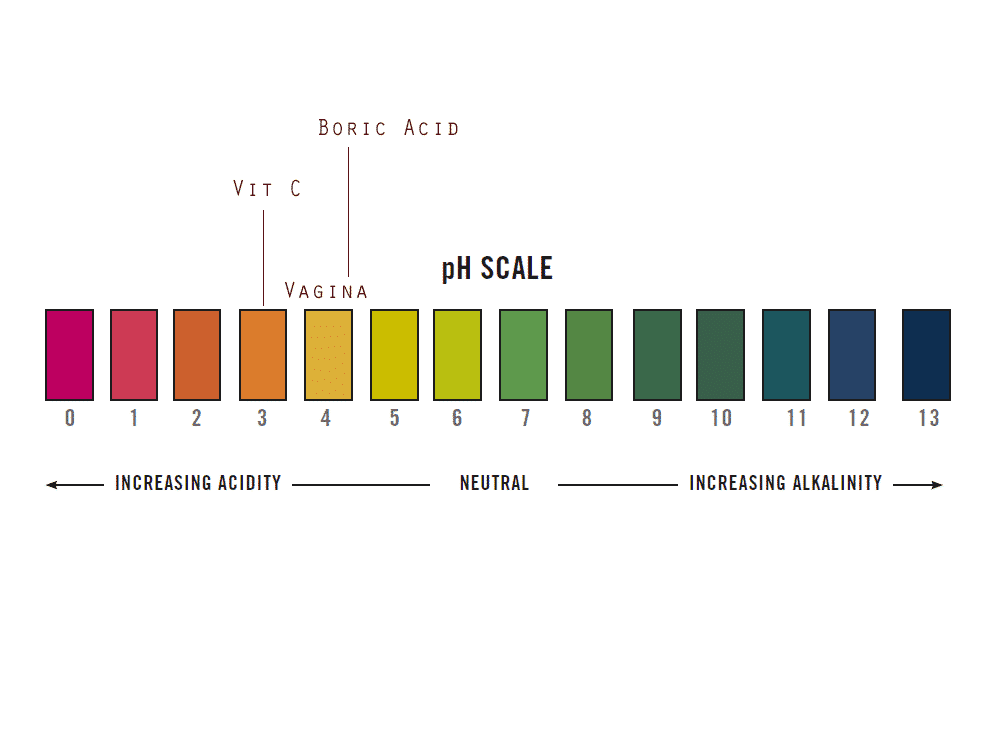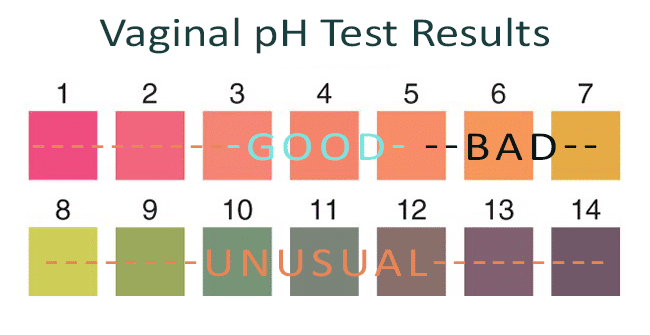Disruptive vaginal bacteria tend to make your vagina less acidic, which might sound good (who wants an acidic vagina?) but it’s not.
Your vagina should be, in chemistry terms, acidic – just a little more acidic than vitamin C between 3.8 and 4.5.1
Just want to test your vaginal pH? Instructions on how to test your vaginal pH at home.
Some context of the pH of different parts of your body and substances
- Water is neutral at a pH of 7
- Skin is slightly acidic with a pH of 5.5
- Saliva is largely neutral between 6.5 and 7.5
- Stomach acid has a pH of between 1.5 and 4.0
- A fertile-age (still menstruating) vagina has a pH of between 3.5 and 4.5
- An unhealthy fertile-age vagina has a pH of over 4.5
- A healthy menopausal vagina has a pH of around 5.5
- An unhealthy menopausal vaginal pH may not be identifiable, but if its above 5.5, may indicate pathogens
- Some vaginas can be very happy at a higher pH without producing symptoms
Don’t worry about the term ‘acidic’, and try to avoid associating the popular concept of ‘alkalising your body’ with an alkaline vagina. These ideas are very different and cannot be linked. An acidic vagina is desirable.
The pH scale goes from 0 – 14. The lower the number, the more acidic the substance.

The acidic vagina
When your vagina becomes less acidic (higher numbers above 4.5), it means potentially disruptive microbes may be present, producing substances that cause a change in pH.
This change in pH is to increase bacterial comfort levels, like turning on the air conditioning on a hot day. Lactobacilli, the protective bacteria that make your vagina acidic, can’t thrive and vaginal dysbiosis occurs.
Dysbiosis means microbially out of balance. It isn’t a disease in and of itself, but a state of altered from desirable microflora.
Why lactobacilli are good for your vagina
Lactobacilli produce lactic acid as part of their normal daily lives, in the same way that we produce carbon dioxide when we exhale.2
Lactobacilli use sugars to produce energy while excreting lactic acid and hydrogen peroxide (which are both acidic). This is actually what you’re testing when you do a vaginal pH test.3
Lactobacilli are the same type of bacteria that turn milk into yoghurt (acidophilus). This might seem gross, but this is why you can make yoghurt out of healthy vaginal secretions!
Lactobacilli don’t create bad smells, though the sour smell of fresh natural yoghurt can make the mouth water.
Bacteria make all kinds of smells because they produce gases and byproducts as part of their lifecycle. Flatulence, for example, is a gas byproduct of our digestion, caused by bacteria.
Testing your vaginal pH at home quickly, cheaply and easily
You can test your vaginal pH quickly and easily at home with vaginal pH strips. You do not need fancy equipment or a doctor’s visit, but you do need good quality, reliable pH strips.4
Ensure pH strips are in at least 0.5 increments to get a more accurate result.
Good pH strips are extra important if you are trying to treat a vulvovaginal condition where pH is one of your indicators of a shift in vaginal flora.
You can push the pH strip into your vagina to collect the fluid, or use a finger to smear vaginal fluids across the strip, or use a cotton bud.
Don’t do vaginal pH testing when you have your period, as you will be unable to read the results.
The pH strip relies on you interpreting the colour it gives you, matching it to the key on the packet to determine pH.
Understanding your vaginal pH test results
To read the results, you need to match the colour that the pH strip turns to the coloured key on the pH strip packet.
Your pH strip colours may vary from the below colours, but check the numbers and colours of your pH tester kit for accurate results.
- Normal vaginal pH is 3.5 – 4.5 if you still get periods/are ovulating
- Bacterial vaginosis or aerobic vaginosis is usually above pH 4.5
- There are some microbes that will cause symptoms but your pH may be normal, in which case aim for a comprehensive vaginal microbiome test to identify the microbes5
- A healthy menopausal vagina usually sits at around 5.5
- It is rare to have a pH of less than 3 or past 9, because vaginal pathogens or bacteria do not tend to produce this pH

Vaginal pH changes across your menstrual cycle
It’s important to note when you do your pH test what day of your cycle you are on. Day 1 is always (as a constant across all medical systems) the first day of your period, so keep a period tracker and mark which days you have which pH to see if it changes.
You are likely to see changes in pH near your period and around when you ovulate. Menstrual blood and semen are both alkaline, so if either of these fluids is present, a different result is likely. The reason for the changes can be oestrogen levels.6
The more oestrogen you have, the more glycogen is produced, and the more food is available for lactobacilli. If you have vulvovaginal symptoms, but a low pH (as in, acidic and healthy levels), you may have what’s known as cytolytic vaginosis (CV) (lactobacillus overgrowth syndrome).
If this is the case, your symptoms will be cyclic and fluctuate with the food supply of the lactobacilli. Symptoms will worsen with ovulation, and you will feel better during your period when the less acidic menstrual blood modifies the environment and low levels of oestrogen reduce food supply.
Chart your pH for a few months as a good baseline while you are healthy, so if your vagina’s pH goes off, you know immediately.
How to ‘balance’ your vaginal pH
Whether or not you can easily shift your vaginal pH is going to depend very heavily on what sort of microbes you have living in your vagina. Some microbes are easy to get rid of, while others not so much.
You can try some easy treatments at home to get your vaginal pH back on track, but if you find they are not working or only working temporarily to stop your symptoms, you are likely going to need a proper test and other treatments.
The first treatment to try is Aunt Vadge’s Lactulose and Probiotic Kit, which comes with everything you need to get started.
Remember that you could have vaginal symptoms associated with an infection, or something a bit harder to get rid of like bacterial vaginosis (BV) or aerobic vaginosis.7 These problems won’t respond very well to general vaginal acidifiers but are worth a try regardless.
If you suspect you have a sexually transmitted infection, see your doctor to be tested. If you have a yeast infection, you may also find relief from symptoms using these acidifiers, but again, if symptoms are not resolved completely after a few days of using these treatments, see your doctor.
Yeast infections don’t present with pH changes, as yeast are tolerant of acid. In this case, working to balance your pH is not the goal, but to increase lactobacilli numbers.
Easy, safe vaginal acidifiers to balance your vaginal pH
- The first treatment to try is Aunt Vadge’s Lactulose and Probiotic Kit, which comes with everything you need to get started.
- Hydrogen peroxide douche
- Vitamin C – only use a small amount (about 100mg), and avoid putting a tablet into your vagina without crushing it up – it can burn and cause irritation – not for long-term use to balance vaginal pH
- Boric acid – 600mg in a vegetable capsule at night until symptoms resolve, but not for long-term use (up to two weeks) – read our factsheet for safe use of boric acid
- Vinegar douche – always dilute vinegar when using as a douche, as it will burn otherwise – a few tablespoons full of vinegar in a cup of warm water can help balance your vaginal pH, any vinegar works 8–10
Remember, you may have a bigger problem than just a bit of an off-smelling or feeling vagina, so if you are failing to balance your vaginal pH, see your doctor!
References
- 1.Lin YP, Chen WC, Cheng CM, Shen CJ. Vaginal pH Value for Clinical Diagnosis and Treatment of Common Vaginitis. Diagnostics. Published online October 27, 2021:1996. doi:10.3390/diagnostics11111996
- 2.Linhares IM, Summers PR, Larsen B, Giraldo PC, Witkin SS. Contemporary perspectives on vaginal pH and lactobacilli. American Journal of Obstetrics and Gynecology. Published online February 2011:120.e1-120.e5. doi:10.1016/j.ajog.2010.07.010
- 3.O’Hanlon DE, Come RA, Moench TR. Vaginal pH measured in vivo: lactobacilli determine pH and lactic acid concentration. BMC Microbiol. Published online January 14, 2019. doi:10.1186/s12866-019-1388-8
- 4.Huppert JS, Hesse EA, Bernard MC, Bates JR, Gaydos CA, Kahn JA. Accuracy and Trust of Self-Testing for Bacterial Vaginosis. Journal of Adolescent Health. Published online October 2012:400-405. doi:10.1016/j.jadohealth.2012.01.017
- 5.Godha K, Tucker KM, Biehl C, Archer DF, Mirkin S. Human vaginal pH and microbiota: an update. Gynecological Endocrinology. Published online December 22, 2017:451-455. doi:10.1080/09513590.2017.1407753
- 6.Miller EA, Beasley DE, Dunn RR, Archie EA. Lactobacilli Dominance and Vaginal pH: Why Is the Human Vaginal Microbiome Unique? Front Microbiol. Published online December 8, 2016. doi:10.3389/fmicb.2016.01936
- 7.Abbe C, Mitchell CM. Bacterial vaginosis: a review of approaches to treatment and prevention. Front Reprod Health. Published online May 31, 2023. doi:10.3389/frph.2023.1100029
- 8.Yagnik D, Ward M, Shah AJ. Antibacterial apple cider vinegar eradicates methicillin resistant Staphylococcus aureus and resistant Escherichia coli. Sci Rep. Published online January 20, 2021. doi:10.1038/s41598-020-78407-x
- 9.Yagnik D, Serafin V, J. Shah A. Antimicrobial activity of apple cider vinegar against Escherichia coli, Staphylococcus aureus and Candida albicans; downregulating cytokine and microbial protein expression. Sci Rep. Published online January 29, 2018. doi:10.1038/s41598-017-18618-x
- 10.C. Patole V, G. Mahore J, D. Nandgude T, Gutte A. Apple cider vinegar: Effective adjuvant treatment for aerobic vaginitis. Novel Research in Microbiology Journal. Published online August 8, 2022:1659-1669. doi:10.21608/nrmj.2022.253697




